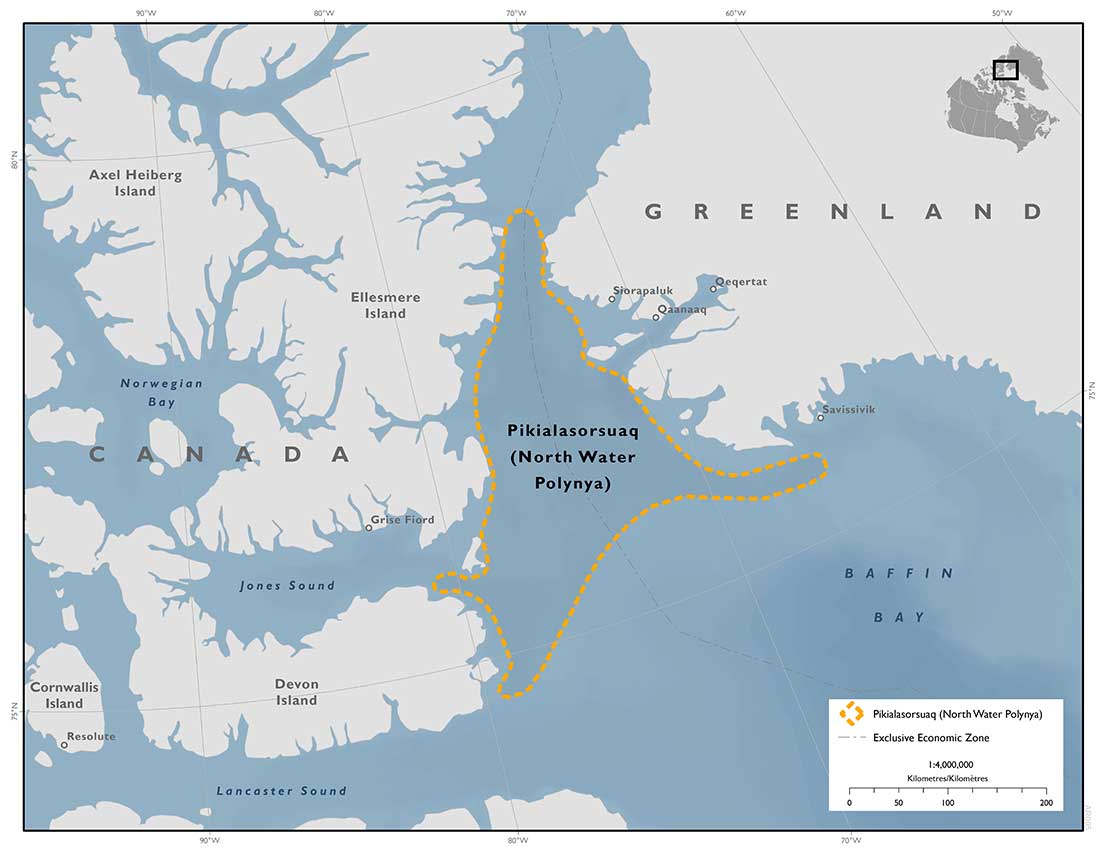Pikialasorsuaq (North Water Polynya)
Location
Pikialasorsuaq is a large polynya (area of year-round open water surrounded by sea-ice cover) located in the northern part of Baffin Bay, indicated on the map by the dotted yellow line. The name means “great upwelling” in Greenlandic and is the word used by Inuit in Canada and Greenland. Early European explorers referred to the area as the North Water Polynya. Canada and Greenland share jurisdiction over Pikialasorsuaq.
Environmental Challenges
There are challenges facing this unique and important ecosystem and the communities that depend on it. Pikialasorsuaq is under pressure from environmental changes taking place in the Arctic, particularly climate change, which could make the polynya less stable. Climate change is also making the polynya more easily accessible, potentially leading to increased development, such as shipping, fisheries, tourism, and mining. These stressors may have serious implications for the marine biodiversity and communities in the area.
Ecological Importance
Pikialasorsuaq is the largest polynya in the Canadian Arctic, and is one of the most biologically productive regions north of the Arctic Circle.
Pikialasorsuaq remains ice-free in winter, providing important habitat for Arctic and migratory species to carry out essential activities such as feeding, mating, and reproducing. It is vital to a range of species, including birds, marine mammals such as walrus, beluga and bowhead whales, narwhals, ringed, bearded and harp seals, and polar bears, as well as fish. The unique characteristics of this polynya also result in a plankton explosion in the early spring, providing food for numerous species.
Conservation Approaches
In January 2016, the Inuit Circumpolar Council (ICC) established the Pikialasorsuaq Commission to recommend an Inuit strategy for safeguarding and monitoring the health of the polynya. The Commission’s report, "People of the Ice Bridge: The Future of the Pikialasorsuaq", was released on November 23, 2017. The report recognizes the importance of this area to local Inuit communities; it sustains Inuit with food and resources, making it invaluable for cultural and spiritual well-being. The report recommends identifying a protected area that includes the polynya and a larger management zone. The report also recommends moving toward Inuit-led management of the region, and free movement across Pikialasorsuaq for Inuit people between historically connected communities in Canada and Greenland.
Advancing reconciliation and pursuing a renewed relationship with Indigenous peoples based on the recognition of rights, respect, co-operation, and partnership is a priority for the Government of Canada. In the marine context, Fisheries and Oceans Canada supports Indigenous leadership and collaboration on marine conservation initiatives. Inuit in Canada and Greenland have begun discussing a path forward to implementing the Commission’s recommendations. The Government of Canada has also begun engaging with key Canadian Inuit partners in support of the report’s recommendations, and has initiated discussions with the Government of Greenland and the Kingdom of Denmark, as Greenland is part of the Kingdom of Denmark.
Resources
- Science Advisory Report - Identification of Ecological Significance, Knowledge Gaps and Stressors for the North Water and Adjacent Areas
- Pikialasorsuaq Atlas and Planning Tool (the Inuit Circumpolar Council collaborated with a range of partners in Canada and Greenland to gather all available Indigenous and scientific knowledge into an Atlas. The Planning Tool illustrates how different activities may overlap or interact with marine resources in the region).
- Date modified:

